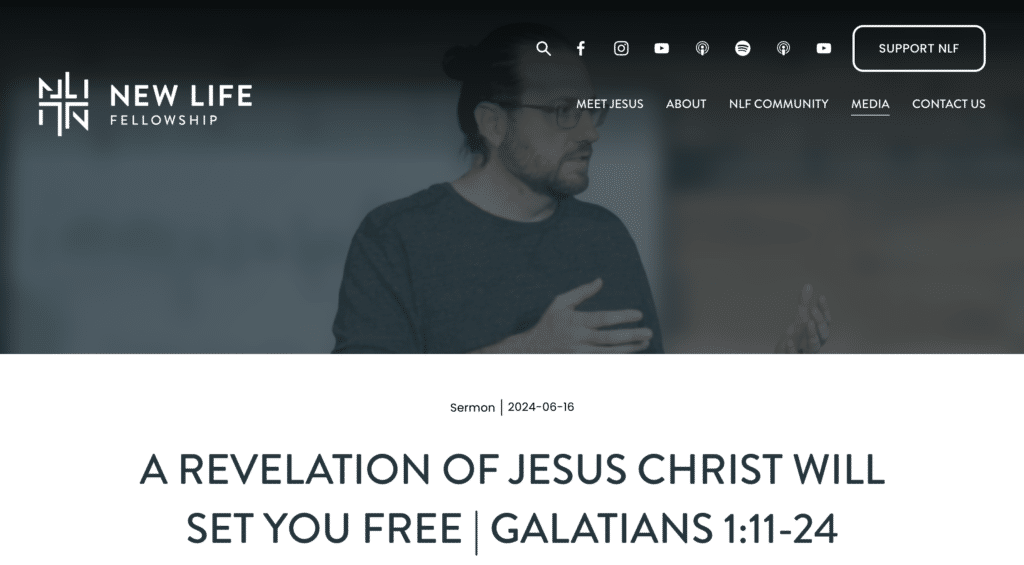Starting a church is a noble and worthy goal. It’s also really flipping hard. I know because I’ve lived it. In 2018, on a warm summer evening, a group of 25 friends (most of us young families) gathered together. We started dreaming of planting a church built around the values of vulnerability, trust, and sharing life.
Today, that idea is a thriving, self-sustained, and grace-filled community called New Life Fellowship. As church leaders, we're excited to see how our members have bought in. Our growth has been significantly helped by church management software, an indispensable tool.
Ross Gilbert is the lead pastor of New Life Fellowship, along with three other pastors (myself included). Today, I’ll reflect on our experience starting New Life, and pass along a structure to help you figure out how to start a church of your own.
New Life’s story is unique, as is every church plant's story, but still, we stumbled over learned some key lessons and truths that will be valuable for you as you plan your own church plant.
In this article, we’ll cover:
- What is church planting?
- How to start a church that is self-sustaining
- What are the growth phases of a successful church plant?
- What are the potholes to avoid?
What Is Church Planting?
Church planting, the act of starting and establishing a new church, is essential for spreading the Gospel, as demonstrated by the Apostles in the New Testament, and is necessary for the growth and vitality of the church. This happens by attracting and discipling new church members. It involves several key steps:
- Pastoral Preparation: a time in the heart of each pastor marked by personal reflection, spiritual growth, and skill development.
- Gathering the Launch Team: gathering, inviting, and forming a committed launch team to help develop and implement the church plant.
- Vision Development: Vision casting, engagement and developing the name and visual identity of your church plant.
- Structural and Operational Logistics: Setting up your church’s legal and financial foundation and registering with the IRS (or CRA in Canada). Building out the structure of ministries, setting church bylaws, etc.
- Launch Preparation: Setting a launch date, recruiting volunteers, and promoting the launch.
- Iterate and Grow: Engaging with the community, refining church operations.

Stages of a Church Plant’s Growth
This section comes with an enormous caveat: this is how New Life Fellowship started. Your church (or church plant) may have a very different experience. However, each of the following phases are key and will be part of any successful church plant
Stage 1: Pastoral Preparation
- Pastoral Call: Confirm your personal and family call of God to church plant. This is crucial.
- Biblical Grounding: Understand scriptural mandates for church structure and leadership, discipleship, etc.
- Take Time: This cannot be rushed. A great thing at the wrong time is still the wrong thing.
For many of us pastors, this phase may not be recognized… but it’s still critical. For Ross, this was a six-year period. For me, God’s preparation for taking on a pastoring role at New Life Fellowship began 4-5 years before plans for New Life began.
Your preparation for leading your own church may be different, but for Ross and me, this preparation period was marked by self-examination and seeking God’s guidance around the pastoral call. God also worked in us to help us develop a deeper understanding of faith and community.
Stage 2: Gathering the Launch Team
- Identify Key Families: Approach families who share the vision and commitment.
- Initial Meeting: Outline the mission and invite participation.
- Team Formation: Form a cohesive team that collaborates and shares responsibilities.
When Ross first approached us about planting a church, some of us immediately agreed. Others took more time to consider. All of us, though, responded to the mission Ross laid out: to be a church where grace is experienced relationally. We wanted to be a church marked by our close-knit community, openness, and care for each other. Over the course of several weeks, we gradually formed the planting team.
Stage 3: Vision Development
- Vision Casting: Together, define the church's mission and core values, and statement of belief.
- Community Engagement: Gather feedback and insights from potential members.
- Choose Name/Develop brand: Select a name, develop a logo, and begin developing online platform.
Our early planning meetings were focused on vision development. We asked questions ranging from the foundational “What kind of church do we want to be?” and “What does a successful church look like to us?” to the practical logistics: “Where should we meet?” These discussions were crucial in shaping our church’s identity. Everyone’s input was valued, and these early decisions were made by consensus, ensuring a sense of collective ownership. During this time, we also selected our name (New Life Fellowship) and developed our logo.

Stage 4: Structural and Operational Planning
- Location Selection: Choose a suitable meeting place.
- Service Planning: Decide on service times and format.
- Logistical Arrangements: Address practical needs like equipment, children's ministry, and hospitality.
- Nonprofit Incorporation: Establish the church as a nonprofit organization for financial and legal purposes, choose a board of directors (church finance committee), and begin developing church bylaws
- Fundraising and Marketing: Develop fundraising strategies, promoting the church, and inviting new members.
NOTE: New Life Fellowship is a non-denominational church, so we were on our own in many respects during the set-up. Your denomination may have resources to help with church planting.
During this time, we worked with several legal and financial professionals to expedite the process of establishing our non-profit status. We registered with CRA (the Canadian equivalent of the IRS) and secured our articles of incorporation.
We also began to purchase key elements we would need for operations (AV equipment, coffee makers, storage equipment, the list goes on and on. Of special note, though, was the church management software(ChMS) we selected, which became our operational backbone. We easily met the basic ChMS requirements, so the tool helped streamline and strengthen our management processes and systems.
Financially, we started with the support of our core families, supplemented by contributions from other communities and our wider networks of support. This helped cover initial costs without the pressure of immediately generating income. We also received helpful guidance and volunteer support from another local church, which would send volunteers to help in our church service.
Stage 5: Launch Preparation
With the bulk of our structural and organizational decisions finalized, we picked a launch date several months out. We selected January 20, 2019 and
- Set a Launch Date: Choose a specific date for the official launch.
- Finalize the Venue: Ensure the location is booked and ready.
- Recruit Volunteers: Assign roles for setup, greeting, children’s ministry, worship, and whatever other service-related roles you need.
- Create Marketing Materials: Design flyers, social media posts, and a website.
- Promote the Launch: Use social media, local newspapers, and word of mouth to invite the community.
We adopted a crawl-walk-run model for our launch, understanding that perfection was not the goal. Our focus was building a community where grace was experienced daily, not just on Sundays. This approach allowed us to learn and grow together, embracing the messiness of collaborative decision-making.
Stage 6: Iterate and Grow
- Start small groups: regular bible study is crucial to help folks develop communities, grow disciples, and strengthen your churches
- Be clear about your core beliefs: Don’t avoid hot-button topics. Be clear about where you stand.
- Adhere to your mission statement: as time goes on, pressures will increase, but keep the main thing the main thing.
- Encourage outreach on a personal scale: Too many Christians expect their church to hold outreach events and neglect the most powerful outreach tool: personal invitation.
Our church leaders have a running joke at New Life about doing a hard launch someday. See, from the beginning, we’d planned to start soft. We’d “practice” church, get into a rhythm and groove, and then ‘hard launch’ with a big marketing push once we were ready to go.
Once we were ready to execute our hard launch, COVID hit, and we were homeless and online. Several years later, we’re still waiting for the hard launch. But we’re growing, and our community is as vibrant and thriving as we have hoped.
What is Required for Your Church Plant to Become Self-Sustaining?
Looking back over our church’s experience, a handful of fundamentally important aspects contributed to our plant's success. Within a year, we doubled in size… then COVID hit. We held our numbers through the pandemic, and as soon as things opened up, we began to grow again.
As I consider the core elements that have contributed to that ongoing growth, I keep coming back to a handful of key things:
Requirement #1: United Leadership Team
We knew we needed a solid team to start our church. Our pastors, elders, deacons, and key volunteers all believed in our mission. This unity helped us make good decisions and kept us strong together.
Requirement #2: Shared Vision
We all had to agree on where we were going and what we wanted our church to be like. We also decided what we didn't want to be. This clear vision guided us right from the start and kept everyone on the same path.
Requirement #3: Thorough Legal Foundation (IRS, CRA)
Getting our legal stuff right was crucial. We ensured we had our charitable status and followed all the rules set by the IRS or CRA. This helped us operate without legal worries and let us focus on our mission.
Requirement #4: Strong Church Management Framework
We had to be clear about who was responsible for what. We set who would handle worship, preaching, greeting, kids, and youth. This clarity helped everything run smoothly and ensured no important jobs were forgotten.
Requirement #5: Reliable Infrastructure
We needed good tools to do our work. This meant having reliable computers, sound equipment, instruments, and even coffee makers. These tools helped us do our weekly services and other activities without trouble.
Requirement #6: Robust, Scalable Software Tools
We invested in good software right from the start. We prioritized church management software that would drastically reduce the administrative and managerial tasks associated with planting a church.
Our leadership team also looked for other software tools to help in key areas outside of church management, primarily:
- church presentation software for projecting sermons and worship lyrics
- church website building software to develop our online presence
These tools have held us in good stead over the years, scaling and growing as we do.
The challenges and complexities of planting New Life Fellowship were numerous, but they are far outweighed by the joy and fulfillment of seeing our church grow into a vibrant community of grace.
Ross Gilbert
Top Five Church Planting Potholes to Avoid:
Looking back, I'd identify five major potholes that could threaten your church plant:
Don’t Rush the Process
Take your time to get ready and grow spiritually. This helps build a strong foundation for your church. Rushing might skip important steps.
Don't Centralize Decision-Making.
Spread out the responsibilities among many people. This prevents any one person from getting too tired or having too much control. It helps everyone feel involved and protects the church.
Follow IRS (or CRA) Guidelines.
Make sure your church's finances are open and follow the rules. This keeps everything legal and builds trust with your community and authorities.
Don’t Overemphasize Sunday Services.
Focus on building relationships and community throughout the week. When you do this, Sunday services will naturally come together. This approach makes your church about more than just meetings.
Don’t Ignore Community Feedback.
Listen to what people in your church think and feel. Use their feedback to shape how you start your church. This makes sure everyone is part of the church's direction and growth.
Note: My team and I have written an article examining common church-plant problem areas in more depth. It's worth your time.
How to Start a Church - FAQs
How important is collaborative decision-making?
Collaborative decision-making can introduce complexity and mess, no doubt about it. However, it’s a crucial part of New Life Fellowship’s culture, for several important reasons:
- We believe that the Holy Spirit leads through unity.
- We believe that collaborative decision-making is a check on ego and pride.
- We believe that the mess is where trust is built, and where grace is experienced.
After all, our goal is to grow a community where healing and life are experienced. That’s our primary vision… and we believe numerical growth will flow from that.
How large should my initial launch team be?
Aim for a manageable group, such as six to eight families or a similar number of committed individuals.
How do I develop the church's vision?
For long term success, ensure that your church launch team helps develop the vision: this will increase sustainability and buy-in. Engage your church launch team in discussions to shape the vision and ensure it aligns with the mission and values. Hold meetings to gather input and feedback from potential members, ensuring their voices are heard and considered.
What are key considerations in choosing a location for my church?
As a launch team, we prayerfully considered the general region or neighborhood God was leading us to minister in. With that area defined, we then looked for potential spots keeping in mind accessibility, size, ability to handle growth, and conducive to a welcoming environment. For you and your church, needs will be different – but God is always faithful.
What challenges might I face with the location?
It’s rare that a church plant gets everything they want in a location. Carefully consider issues like lack of storage, the need for transportable equipment, and plan accordingly. There are also some additional legal hurdles that religious organizations face in getting charitable status. We highly recommend working with experts through this process.
What steps are involved in legal incorporation for a church?
We relied heavily on experts to guide us through this process. As a result, we moved through it more quickly than expected, with fewer headaches. Choose a legal structure, write and file bylaws, obtain an EIN, and consider applying for 501(c)(3) for tax-exempt status. In Canada, this looks like working with CRA to secure a BN and getting charitable status.
The Lead Pastor is Here To Help Your Church Grow
By subscribing to our newsletter, you can get fresh, in-depth insights on various topics, from church technology and marketing to church administration and finance. Learn more by subscribing to The Lead Pastor newsletter.



